Guide to Connecting a Distributed Generator - Sustainability Victoria
Guide to Connecting a Distributed Generator - Sustainability Victoria
Guide to Connecting a Distributed Generator - Sustainability Victoria
You also want an ePaper? Increase the reach of your titles
YUMPU automatically turns print PDFs into web optimized ePapers that Google loves.
Appendix 3: Additional matters <strong>to</strong> coordinateRegulation of generating plant fuelled by gases or inflammable liquids 8Where applicable, applicants are obliged <strong>to</strong> comply with the following regulations, among related requirements, if theinstallation uses an engine, gas turbine, fuel cell or other equipment which is fuelled by natural gas, LPG, biogas, petrol,diesel fuel, distillate or other inflammable source:• Gas installation code (AG601)• Code for industrial and commercial gas-fired appliances (AG501) (www.blis.tas.gov.au)• EPA policy on noise emissions (www.epa.vic.gov.au)• EPA policy on atmospheric emissions (www.epa.vic.gov.au)• MFB and CFA requirements• Local municipal planning and building regulationsWhere electrical equipment (including genera<strong>to</strong>rs) is located at, or close <strong>to</strong>, sources of inflammable gas or vapour, it is alsonecessary <strong>to</strong> follow the Hazardous Area Standards (see Standards Association of Australia HB13) in order <strong>to</strong> mitigate risksof explosion. It is common <strong>to</strong> provide protection ventilation (AS1482) and <strong>to</strong> exclude as many electrical accessories aspossible from the hazardous area.Metering arrangementsThe applicant is responsible for appointing a metering provider <strong>to</strong> install and maintain metering equipment at the locationagreed with their DNSP. The type of metering installation required and its accuracy requirements should be in accordance withthe National Electricity Rules (Chapter 7) unless otherwise agreed with the electricity retailer or metering provider. Proponentsshould ensure that they understand their responsibilities with regard <strong>to</strong> these functions.Minimum standards for new metering equipment 9 (for a non-market genera<strong>to</strong>r)• Metering equipment for medium DG operating as a non-market genera<strong>to</strong>r must comply with the minimumstandards for metering installations as prescribed in the Rules for market genera<strong>to</strong>rs.• Metering equipment for small DG operating as non-market genera<strong>to</strong>rs must comply with the minimum standardsof accuracy for new metering equipment for electrical installations with consumption of less than 100 GWh perannum, in accordance with the Vic<strong>to</strong>rian Electricity Cus<strong>to</strong>mer Metering Code.• Metering equipment for medium DG non-market genera<strong>to</strong>rs must be able <strong>to</strong> measure active energy andreactive energy.• A distribu<strong>to</strong>r may require the metering equipment for small DG or micro DG operating as non-market genera<strong>to</strong>rs<strong>to</strong> measure active energy and reactive energy taking in<strong>to</strong> account the size of the genera<strong>to</strong>r, its proposed role andits location in the network.• Metering equipment for non-market genera<strong>to</strong>rs must be able <strong>to</strong> measure positive and negative flows separatelyand for the avoidance of doubt this metering requirement allows the cus<strong>to</strong>mer load and the non-market genera<strong>to</strong>r<strong>to</strong> be connected <strong>to</strong>gether on the cus<strong>to</strong>mer’s side of the meter so that any exports are ‘net metered’.• Where avoided cost payments or tariffs for the purchase of electricity from the non-market genera<strong>to</strong>r are basedon different rates according <strong>to</strong> the time of day, interval metering equipment must be installed.It is in the best interests of the applicant <strong>to</strong> refer <strong>to</strong> the Electricity Cus<strong>to</strong>mer Metering Code published by the ESC.8. Extract from the Cus<strong>to</strong>mer <strong>Guide</strong>lines for embedded generation of rating up <strong>to</strong> 1MW, Powercor Australia.9. Extract from Draft National Code of Practice for Embedded Generation, DRET 2006.30 - <strong>Guide</strong> <strong>to</strong> <strong>Connecting</strong> a <strong>Distributed</strong> Genera<strong>to</strong>r in Vic<strong>to</strong>ria




